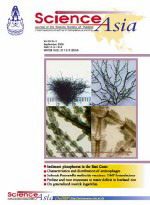ThaiScience
ThaiScience
SCIENCE ASIA
Volume 46, No. 02, Month FEBRUARY, Year 2020, Pages 142 - 150
The disease specific proteins in striatum of the mouse models of parkinson s disease induced by rotenone and mptp
Changqing Zhoua,*, Shanshan Lib, Min Wangc, Zhongmei Chend, Guoguang Peng
Abstract Download PDF
Parkinson"es disease (PD) is the second most common neurodegenerative disease. To explore the disease-specific proteins (DSPs) of PD, two mouse models were established with rotenone and 1-methyl-4-phenyl-1, 2, 3, 6-tetrahydropyridine (MPTP). A strategy of two-dimensional gel electrophoresis (2-DE) in combination with matrix-assisted laser desorption ionization time-of-flight mass spectrometry (MALDI-TOF-MS) was used to identify the common differentially expressed proteins in striatum. There were significant differences in behavioral evaluation and the numbers of tyrosine hydroxylase (TH) positive neurons between the rotenone group and control group 1 and between the MPTP group and control group 2 (p < 0.01). Maps of 2-DE were analyzed with PDQuest 8.0 software and 21 differentially expressed proteins were found between rotenone group and control group 1; 27 were found between MPTP group and control group 2. Six common differentially expressed proteins were found in the two mouse models of PD and 3 of them were ultimately identified successfully with MALDI-TOF-MS and database analysis: FEM1B, Pyridoxal kinase and α-SNAP. All the 3 common differentially expressed proteins were down-regulated in rotenone group and MPTP group compared with control group 1 and control group 2, respectively. These proteins are primarily associated with apoptosis, degradation of proteins, synthesis and transportation of neurotransmitters and they may be the DSPs of PD.
Keywords
biomarkers, proteomics, striatum, two-dimensional gel electrophoresis, time-of-flight mass spectrometrySCIENCE ASIA
Published by : The Science Society of Thailand
Contributions welcome at : http://www.scienceasia.org/
